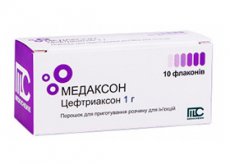Medical expert of the article
New publications
Preparations
Medaxone
Last reviewed: 04.07.2025

All iLive content is medically reviewed or fact checked to ensure as much factual accuracy as possible.
We have strict sourcing guidelines and only link to reputable media sites, academic research institutions and, whenever possible, medically peer reviewed studies. Note that the numbers in parentheses ([1], [2], etc.) are clickable links to these studies.
If you feel that any of our content is inaccurate, out-of-date, or otherwise questionable, please select it and press Ctrl + Enter.

Medaxone is an antibiotic from the cephalosporin category, administered parenterally. It has bactericidal activity.
Indications Medaxone
It is used to treat various disorders:
- infections caused by the activity of microflora that is sensitive to ceftriaxone (including lesions affecting the respiratory tract, ENT organs, bones and joints, peritoneum, epidermis, kidneys, urinary tract and connective tissues);
- sepsis or meningitis, as well as infections in the urogenital area;
- pathologies of infectious nature in people with weakened immune defenses.
It is prescribed to prevent the occurrence of infections in the periods following surgical procedures.
Release form
The product is produced in the form of a lyophilisate for the preparation of injections (intravenous or intramuscular), inside glass vials with a capacity of 500 or 1000 mg. There is 1 such vial inside the pack.
Pharmacodynamics
The drug's effect is based on the suppression of cell wall binding processes. The drug has bactericidal activity against a wide range of microbes and at the same time demonstrates resistance to enzymes produced by bacteria (cephalosporinases with penicillinases).
Pharmacokinetics
The element ceftriaxone after parenteral administration is absorbed at high speed and passes into the tissues and body fluids.
The average half-life is 8 hours; in older people this period is almost twice as long.
The level of bioavailability after intramuscular injection is 100%. The bactericidal effect of the drug on sensitive bacteria continues for 24 hours. Synthesis with protein is 85-95%.
Excretion of unchanged ceftriaxone in urine is 50-60%, and another 40-50% is excreted in bile.
Dosing and administration
The medication should be administered intravenously or intramuscularly. Usually 1-2 g of the drug is administered per day (1-time procedure). Injections should be given at intervals of 24 hours. Sometimes (in severe forms of pathologies or in the presence of bacteria with moderate sensitivity) the daily dosage may be increased to 4 g.
Adolescents over 12 years of age are administered a daily dose calculated according to the scheme of 20-75 mg/kg. If the child's weight is more than 50 kg, the medication is administered in adult dosages. Dose sizes for newborns should not exceed 50 mg/kg.
The duration of the treatment cycle is determined by the type of pathogenic bacteria, as well as the nature of the pathology. It usually lasts from 4 to 14 days.
To prevent the occurrence of infections after surgical procedures, a single injection of the drug in a dose of 1-2 g is administered 60 minutes before the start of the operation.
 [ 2 ]
[ 2 ]
Use Medaxone during pregnancy
It is prohibited to use Medaxon during pregnancy or lactation.
Contraindications
Main contraindications:
- presence of severe sensitivity to the drug;
- renal or hepatic insufficiency;
- history of bleeding or diseases affecting the gastrointestinal tract (ulcerative colitis or enteritis).
Side effects Medaxone
The use of the medication may cause the occurrence of certain side effects:
- local manifestations of allergy: urticaria, itching, fever and rashes. Occasionally, eosinophilia, MEE, bronchospasm, anaphylaxis and serum sickness appear;
- digestive disorders: vomiting, constipation, stomatitis, bloating, nausea or diarrhea, as well as enterocolitis, stomach pain, taste disorders and dysbacteriosis;
- disorders of hematopoietic function: neutro, leukopenia or granulocytopenia, hemolytic anemia, as well as hypocoagulation;
- problems with the kidneys and urinary system: hematuria or anuria, azotemia or oliguria, and also an increase in blood urea levels;
- Others: pain along the vein, nosebleeds, dizziness, phlebitis, headaches and candidiasis.
 [ 1 ]
[ 1 ]
Overdose
In case of intoxication with Medaxon, the severity of negative symptoms may be potentiated.
Interactions with other drugs
Due to the lack of compatibility between ceftriaxone and aminoglycosides, they should be used separately, without exceeding the prescribed dosage.
Ceftriaxone is also not compatible with ethyl alcohol.
Chemical incompatibility does not allow mixing the drug with other antibiotics in the same syringe or infusion container.
Storage conditions
Medaxon must be kept at temperatures not exceeding 25°C.
Shelf life
Medaxon can be used within 24 months from the date of release of the therapeutic agent.
Analogues
The analogs of the drug are Axone, Megion, Lifaxon, Azaran with Betasporin, as well as Biotrakson, Longacef, Stericef and Lendacin with Movigip. The list also includes Rocephin, Triaxone, Cefatrin, Torotsef with Hizon and Oframax, as well as Tercef, Cefogram, Forcef, Cefson with Cefaxone, Ceftriaxone and Ceftriaxone sodium, as well as Ceftriabol.
Reviews
Medaxon receives positive reviews from patients who note its high therapeutic effectiveness. Although there are also people for whom the use of the drug did not bring the desired result. But in these cases, commentators did not mention conducting tests to help determine the sensitivity of microbial microflora to drugs, and this parameter is extremely important for ensuring the effectiveness of therapy using antibiotics.
Attention!
To simplify the perception of information, this instruction for use of the drug "Medaxone" translated and presented in a special form on the basis of the official instructions for medical use of the drug. Before use read the annotation that came directly to medicines.
Description provided for informational purposes and is not a guide to self-healing. The need for this drug, the purpose of the treatment regimen, methods and dose of the drug is determined solely by the attending physician. Self-medication is dangerous for your health.

